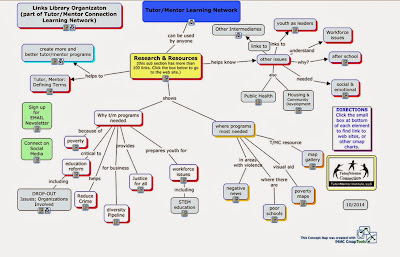using Hypothes.is
Thanks for the invitation. You and Kevin introduced me to Hypothe.is several years ago.
using Hypothes.is
Thanks for the invitation. You and Kevin introduced me to Hypothe.is several years ago.
Contribute a meaningful legacy to a cause you care deeply about—whether financial, strategic, or creative.
Here's another set of articles on my blog that I hope are a meaningful legacy to a cause I care deeply about. click here
Document your wisdom, stories, and learning.
I spent the past few years digitizing my records with the hope that someone will value the journey I've piloted and use it to guild their own efforts.
This is one series of articles on my blog where I point to my archive.
people, and ideas
The posts I read from you, Kevin, Sarah and Sheri, along with many others, constantly enrich me.
Continue building strategies for health and vitality.
I'm not nearly as invested in this as I should be.
Contribute to Something Larger
I think I've been doing this for many years.
share your ideas widely
This has become more difficult as platforms fragment and commercialize.
I only have five more good years before I die
I hope this is not an announcement, or prediction, but just speculation.
If it's a fact, maybe we can plan to go at the same time!
The most important point to my prompt is simple–have a conversation with the AI.
Are you still using the free version of Chat GPT or do you need to be a subscriber to do the level of interaction that you've been showing in your blog articles?
This might be great for introverts. It gives them a friend to interact with that they might not have otherwise.
Also, if there is only so much energy for attention,then as teachers and mentors and learners we have to be careful about the demands we make on that attention.
This is the current I've been swimming against for 30 years. I've aggregated a growing library of information that people can use to understand poverty and take actions to help kids in those areas move through school and into jobs out of poverty.
In the past few years I've been moving all of my paper files to my digital library, creating even more information.
But, with "only so much energy for attention" will anyone ever really use this?
My answer lies in your "audience of one" comment. I don't need "everyone" or "most people". I just need a few who will dig through this and make use of it in their own actions.
annotation in the margins is a way to engage with the text at least as an audience of one reader
You got me.
Have you cast into the quiet pool of light that opens unto the morning?
This is also an important question. Experienced fishermen know where to look for fish and when the best time to catch them is.
What's the best platform to cast social media messages? What's the best time to post?
And, by the way, what was your bait?
This is the agonizing question. "Was I prepared well enough? Was my message creative and cast effectively into the water?
intent
This is the word that I'm not certain about. Replace with "self".
Did you prepare your self to maybe come back empty?
Did you not know this could happen?
Experience is a lesson that teaches us to expect no responses to the bait we cast into social media waters.
The master is the one who stays on the path day after day, year after year
I created a concept map several years ago to archive Twitter conversations. I clicked on #Rhizo14 today and scrolled through past conversations. I found a link to this annotated conversation and read through the comments again. I saw that I was one who had posted.
I highlighted this text because that's what #clmooc community has done for the past 10 years and what I've done for the past 30 years. Along the journey we meet many friends, learn from strangers and hopefully make a small, positive, difference in the world.
potential benefits
I've been sharing ideas via email, websites, blogs and social media since late 1990s. My goal is to motivate people to use AI and traditional search tools to look for "tutor mentor" plus words in this tag cloud where they will find much of what I have posted.
Over time links will break and in future years I won't be alive to keep sites on-line. So, will future AI tools reach into the Internet Archive to find ideas posted on sites that are no longer active? Can our ideas live longer than we do?
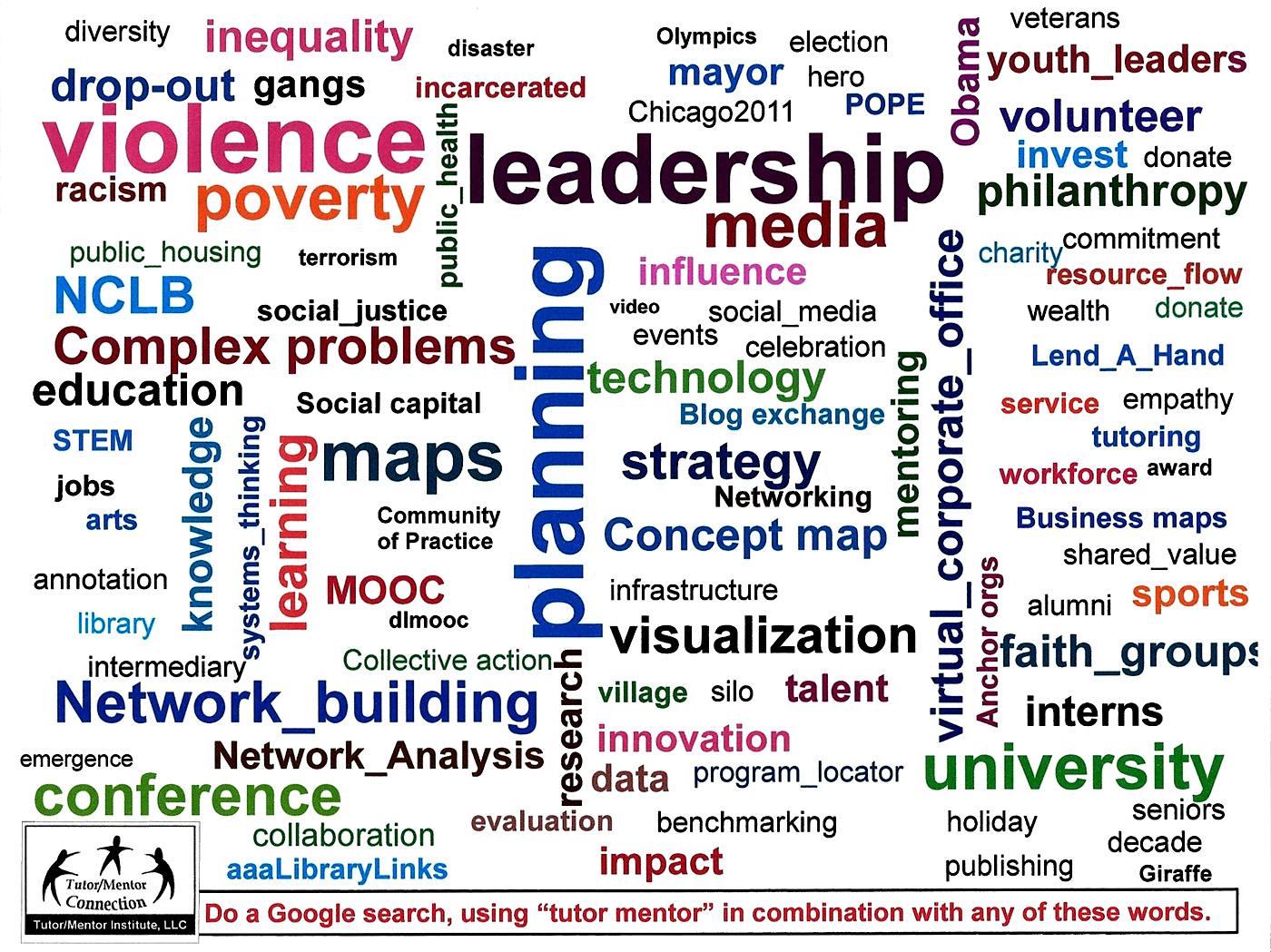
while the Better Without AI website
I read a couple of chapters of the betterwithoutai website. It seems to me that the ChtGPT response could have been generated without ever digesting all the information provided in the many pages of the betterwithoutai site.
My library has been built over 20+ years and I often wonder if any one will ever spend time visiting the links and learning from everything that I"ve collected. I doubt it.
I feel the same about the growing library of AI stuff. Only a few will dig deep into this stuff. Certainly not enough to affect public policy and future directions and/or controls.
An invitation
Terry's Tweet was an invitation.
The yellow highlights on his blog was another lure, inviting me to take a deeper look.
I enjoyed your poems.
This is a space I might have missed, if not for the time I spend on Twitter today.
Pay your bills if you can. Stay alive.
This has helped humanity continue its forward journey for over 6000 years.
A low-ambiguity keynote
Are you referring to this "Logics of Caring" article?
s you pay your bills and manage to stay alive
Here's the bio for Venkatesh Rao, He makes a living as a consultant to senior executives and a writer. I doubt that he worries about paying his bill and staying alive.
That's not the reality of millions of people in the US and the world.
I’ve spent the last few weeks making a clock, building Meccano models, and re-reading the Sherlock Holmes canon
Many don't have the resources to live these experiences.
relatively ignorable obscurity
Really?
There is no obvious animating mood to surrender to, fiercely resist, or imaginatively break from.
I disagree. The GOP moves to take society back 150 years is an animating fear that carries over from 2022 and grows stronger. The Putin attack on Ukraine and uncertainty about that outcome continues for another year.
derangement syndromes
Here's the Free Dictionary definition:
What one is said to experience when they hear about someone or something that causes them extreme, almost irrational anger or frustration. The phrase is often applied to strong negative reactions to a specific politician, so a person's name often precedes "Derangement."
until January 2017
This is when Trump became President.
I wrote this in January 2017 with headline of "Conflicted: How to focus long term when world around is in turmoil?"
logics of caring
Ah ha. Now back to the title of this essay.
none of us knows quite how to feel about the year ahead
This ambiguity is paralyzing. I fear for the year ahead, and for the decade ahead.
Now of course, that’s gone
I don't think it's fully gone. Using a #hashtag you can still connect with a small group of people around an idea.
However, the hype and fear (and reality) of MUSK-owned Twitter is dominating the newsfeed. Along with politics, war, the economy.
an undercurrent of emotional sensemaking
Can either of you offer a #hashtag that might give a lurker's glimpse at a few of the January interactions he is referring to?
I do agree with the idea.
usually human-scale public fun to be had
The #clmooc clan has made this an art form with their daily creates, short poems, Sunday photos, etc.
momentum of lifelessly evolving circumstances
When we look forward we see a universe of possibilities and challenges and time stretches forward, minute-by-minute. Yet, when we look back we only see a shrinking road to nowhere which you've traveled faster than you can imagine.
Adopting an emotional posture towards the year ahead is necessary, and perhaps sufficient to get going.
Not sure about this. Each day we awake and face survival tasks, which differ for each of us. These are what "get us going" weather we're ready or not.
So you have to decide how to care about the world before you can get going
Every day we step forward into ambiguity.
So much is written about "grooming" now days. Is how we were raised a form of "grooming"? Does that give some people better ways to "decide how to care about the world?" I don't know. Who decides what is "better"?"
you cannot just cold-start a year
I don't think I have ever made a list of "new year's resolutions".
On my blog is an archive of posts made each month in past years. Thus from 2006 to 2023 you can see what I wrote in the first two weeks of January. This is from 2006.
These are not new resolutions as much as they are renewal of commitment.
nihilism
He used this word at least three times so I had to look up the definition. Here's one response:
"Nihilism is the belief that all values are baseless and that nothing can be known or communicated. It is often associated with extreme pessimism and a radical skepticism that condemns existence. A true nihilist would believe in nothing, have no loyalties, and no purpose other than, perhaps, an impulse to destroy."
In resolution times we need an emotional posture a direction-setting mood a vibe vector a default disposition
I wonder why, or how, we got to the point where the turn of the calendar from one year to the next, became a renewal, a re-start, or a new beginning, of life's on-going journey.
This image was created by Gene Bellinger about 10 years ago to show the on-going cycle of problem solving. 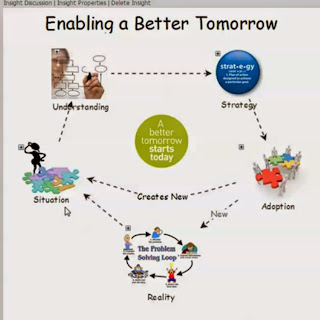
I included it in this article.
Maybe January 1, or the start of a new year, or new cycle, is really a different date for different people. Then again, maybe many are not purpose-driven, and "new starts" don't really have much meaning to them.
Who knows.
The most interesting thing going on in the world right now is literally the weather.
Thanks for the invitation to read and reflect with you. I read your poem before reading the article. I think you pulled concepts but left out context.
I'm going to take another dive, and add some thoughts, but this is a starting point to challenge. I'm not sure i or many others would agree that "the most interesting thing going on in the world right now is the weather."
And finally, find your fellow rebels.
Thanks for shaving this article via Hypothesis. I saw it yesterday on your blog. This final piece of advice is one of the most difficult. Finding people who share the same goals and vision in a world of complexity and busy people is difficult, especially if you are not someone with a big budget or established reputation. I know that from my past 30 years of work.
However, keeping these connections over many years is just as difficult. Of the few people who I've found who seemed to support and share my visions, several have died and are no longer with us.
Of the many who I've built loose ties with, many no longer are at the same organizations. Or we've lost contact as the platforms we used to connect have disappeared.
Defining manufactured doubt andidentifying the methods for its implementation are ne-cessary for developing strategies to counter its effectsand prevent propagation.
I'll add this article to my library. Unless more people see it and read it there will be too little response.
the US federal government has manu-factured doubt, with assistance from the media, aboutthe true rationale and justification for conflicts and warsthe US has engaged in for several decades
Iraq. Others.
“revolving door” between industriesand the agencies
This is the grease that makes much of this work.
The average individual can be easily swayed to denial
Thank you "FOX news" and right wing radio for your contributions to misinformation. .
doubt perpetuators knowingly or unknow-ingly spread false information give
This is happening in American politics.
working definition for manufactured doubt
Who funds this stuff is critically important. I've been aggregating some links to articles that focus on this. Here's one under headline of :Mapping the Koch network and funding of radical Christion right.
Here's another, under headline of “The Koch Libertarian Project vs America”
manufactured doub
I would like to see a review of the far right's disinformation campaigns of the past decade or longer.
This list of tactic
These tactics stretch back more than 100 years in some cases.
obacco, coal, and sugar industries, manufacturers of the pesticide Atrazine, andthe Marshall Institute, an institute focused on climate change research, and other scientists from the era thatassociated with those in the Institute
I wonder if they looked at the gun industry, too?
what we intend
I remember the first time I fired a pistol during a training exercise when I was in the Army. After firing my shots I looked at my target and there were no holes. However, it looked at the target next to mine, and it had double the number expected. You don't always hit what you think you are aiming at.
a means to document and share responses to that question
How might artists draw attention to this question? "What are all the things we need to know, and do, to assure that every child born in poverty today in a job, starting a career, by mid 20s?" In this article I ask the question and show how Kevin posed a reflection using a cartoon. 
personal discovery
I discovered this post via Twitter then went to the blog and saw the notes in the margins. Thus, I'm here, and loving the interaction. It's always worth the journey.
the far country where we travel together
I joined the ETMOOC in Jan 2013 because I saw the participation map. I followed that to CLMOOC a few months later and showed that map with a suggestion that CLMOOC do the same, they did. A few years later we had a Twitter chat of "who's here and who's not" which i pointed to in this article. 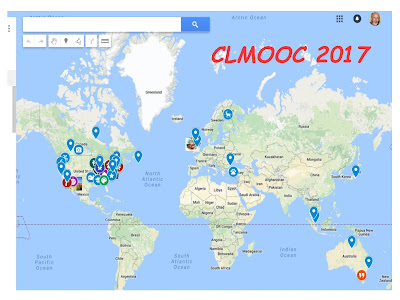
Without some sort of mapping and analysis we don't know ho we're traveling with or where they are located. I wish this conversation had continued.
I made this.
Isn't this a feeling that we might hope to inspire in all kids? And sustain it through adult lives?
Read the deck,
Thanks for encouraging me to read the article and view the deck.
If they keep this up, liberals and conservatives may start talking for real, and maybe even fix a thing or two
Gee. Would anyone be willing to look at my "race poverty" concept map and annotate it to say "that's a problem" or "that's not a problem"?
In doing so, add "for affluent people" or "for poor people" when saying it is, or is not, a problem. Perhaps even add location info. For instance, that's not a problem in Lake Forest, Illinois. Or, that is a problem in the Austin neighborhood of Chicago. 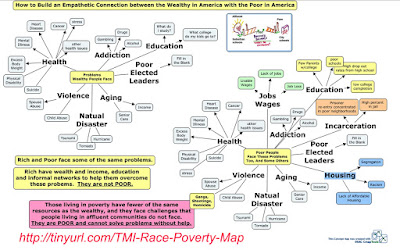
That doesn’t just hurt Trump and conservatives, it misinforms the whole public.
Until journalism and media receive public funding, their use of "sensationalism and 'untruths' to capture attention, and advertising revenue, probably won't change.
information that is true but doesn’t cut the right way politically is now routinely either non-reported or actively misreported
The average person is misled and knows not who to trust for honest, unbiased information.
This is not a new phenomena. However, the Internet has made it possible for more people to see these distortions.
“You’re a MAGA-enabler!” has become the answer to all challenges.
Will this ever have the political power of "You're a socialist" or "You're a communist" or "You're a radical lefty"?
Finally, content collapse consolidates power over information, and conversation
While the momentum may not be in our favor I feel that as long as there are people like Terry Elliott who take the time to dig deep into ideas of others, and into tools to share those ideas, then creates articles like this to pull it all together, we have a hope that we can pull others out of the flow and into deeper contemplation, which is what Terry has done by setting up this Hypothes.is.
In Jan 2019 Terry opened one of my blog articles for others to comment on.
journalism ginned up to trigger reflexive mouse clicks
I saw this Tweet yesterday: "So misinformation was free and facts were hidden behind a pay wall?...And you all wondered why democracy was brought down by masses peddling conspiracy theories?!?"
The business model media used to cover their expenses was fatally flawed. They had to sensationalize their stories and headlines to attract clicks and advertisers. What if in the 1990s they could have figured a new source of funding not dependent on advertising?
information that had required specialized mediums — newspapers and magazines, vinyl records and cassettes, radios, TVs, telephones, cinemas, etc.
Prior to computers and desk top publishing, only a few people were able to communicate to large groups of people and those were people with large advertising, PR and communications budgets. I was at Montgomery Ward when I created this ad in the 1970s. 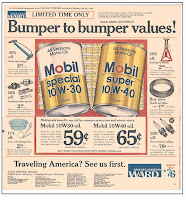
Meeting the ultimate goal for mitigating climate change will require long term public investment to get to 100% renewables (and zero emissions) from the electricity sector by 2050.
As long as the Senate is filled with men and women older than 70 who have been in office for 16 years or longer I don't see any creative leadership emerging to address this issue. We need younger, more creative thinkers, who are less tied to corporate and wealthy donors.
CONCLUSION
This is a topic I've been interested in since the mid 2000s but I've never had the resources and/or talent to build a network analysis tool and apply it in the tutor/mentor program I led until 2011. This discussion thread is from a network analysis group I formed on our Ning site in 2009.
also consider tracking relationship quality indicators over time if they hope to increase the likelihood that these professional connections outlast the progra
When this thinking is built into program design it leads to conversations about program sustainability. If a program cannot stay alive and connected to students and volunteers for multiple years it can do little to build long-term bridging social capital.
Are students expanding their networks through program activities?
This is something that foundations need to look for if programs are going to build this into their design.
. To do this well, programs must start to treat relationships as outcomes in their own right, quantifying and tracking them over time alongside academic metrics
This has to start with program design. Many are not designed to create long-term bonds between students, volunteers and staff.
networks are an asset that students will rely on long after they
I met Leo in 1973 when he was in 4th grade, as a result of my joining a volunteer-based tutor/mentor program. We're still connected in 2020. 
education pipeline
I've used various graphics to visualize this pipeline, including this cmap, which you can find in this article.
early inno
This frustrates me so much. I've been trying to find people doing this work for more than 15 years.
diversit
Diversity is not just race, but age, experience, educational level, geographic location (where the volunteer lives or works and where the youth lives and attends school).
Diversity of students’ networks—across racial, ethnic, socioeconomic, and professional lines—undergirds all four of these dim
This image from a 1980s yearbook of the tutor/mentor program I led in Chicago shows just some of the diversity of volunteers involved. Each of these people was a one-on-one tutor/mentor but also took a role in leading the organization. 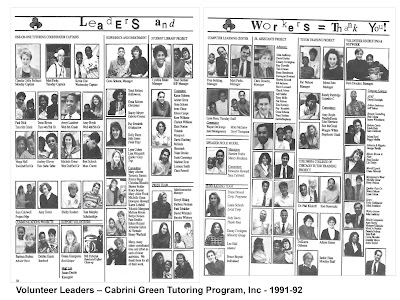
social capital.
Having led a volunteer-based tutor/mentor program for 35 years I've seen how the social capital of youth and volunteers expands as a result of being part of these programs. However, I've found few who describe their mission from a social capital lens or who have been measuring growth of social capital over years a youth is part of an organized program. That's why this article is of interest to me. 
defining criteria for storytellinggrantmaking
I don't see any discussion about this in the white paper.
What are the grant making guidelines? What criteria will be used to determine who gets funding? What metrics or impact measured need to be demonstrated? What percent of a journalist's total cost to operate will be funded? For how long will grants last? If single year this means journalists will be spending time every year looking for grants.
It's almost how elected officials are constantly fund raising to stay elected.
look beyond the known actors
This is part of on-going discover research that should aggressively look for people working in this space.
We should continue to reach out to people working in more innovative news and narrative spacesto think outside of restrictive journalism norms.
Building a network starts with building and maintaining an information base with links to who is doing existing work, along with a database that can be used to contact and share ideas with everyone in the information base.
It's what I was doing from 1993 to 2011 and still do to a limited extent.
non-traditional pipeline programs for journalism
Start training future journalists and story tellers when they are entering middle school.
function as connectors between Field and potential grantees in ALAANA communities
This a role I've taken since forming the Tutor/Mentor Connection in 1993. It was inconsistently funded through 2011 when I created Tutor/Mentor Institute, LLC to keep it available to Chicago. As a LLC I've not been eligible for philanthropic funding. Here's one article.
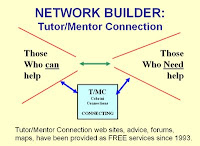
link groups and issues across the city
Platforms should include lists of ALAANA media with maps that show where they are located and what areas they serve. These list could be in many formats.
citywide online news portal
This is similar in concept to what Layton Olson has been advocating for. If news is "information" then platforms like I've been hosting since late 1990s should be included. I first shared this graphic in this 2012 article.

corporate media still defines what is newsworthy, if not for most Chicagoans, then certainly for its most powerful residents
This is an important observation. If the powerful in Chicago are not looking at our stories, Tweets, FB posts, etc. how can we engage with them and influence their thinking and actions?
The city is segregated geographically and it seems also in it's news and communications ecosystem.
LOCAL MEDIA AND STORYTELLING WHITE PAPER
I listened to an interview today with Field Foundation President Angelique Power. She mentioned this White Paper and I asked the Foundation on Twitter if they would share it. They did. I decided to annotate it as I read it.
uling, Justice Ruth Bader Ginsberg
Interesting. Justice Ginsberg is perceived to be one of the liberal Justices on the Supreme Court. Maybe not in all areas?
voter registration and voter mobilization
At some point this needs to focus on electing people who will pursue these policies. It does not matter if they call themselves Democrat or Republican or Green or something else. But majorities need to be developed in city, state and federal houses of government, or none of these demands will be achieved.
Investments in Our Future.
Andrew Yang proposed some form of tax on internet companies, a way of asking them to compensate users for how they mine and use their data. I think this should also be included for discussion in a future version of this budget.
Lifting poverty wages, restoring the safety net,
This was written in 2019 before Andrew Yang launched his campaign around the idea of Universal Basic Income.
I wonder if a future version will include UBI in some form.
Poor People’s Campaign
It's June 20, 2020 and I just finished watching two hours live of the Poor People's Campaign. As I heard calls for cuts to the military budget I asked "what about the jobs that would be lost?" I wondered how this was being addressed, so I went to the web site, and saw that this budget could be downloaded. I did not know it was more than 120 pages long! However, I did open it and skimmed through to pages 104 and 105 where the cuts to the military were itemized and where there was a discussion of lost jobs and how to replace those.
That satisfied my curiosity, however, in opening this, I was called to read the whole thing. I decided to put it on Hypothesis so I could highlight and annotate as I read. I'm starting now. It will take a few days to read the entire budget.
us
I followed the crumbs of the trail you've left over the past few days and now I'm here.
I followed the links to several of Harold Jarche's articles, and the links he points to. I've followed him since late 2000s and point to his writing in my web library.
You used the word "us" in this poem, and I think you really mean "yourself, Kevin, and now me", or those who are connected on a small journey of interaction.
I think Jarche points to a much larger "us", connected people in all parts of the world, trying to make sense of what affect them and those they care about, on a daily basis.
The Entanglement world of the future requires many "US" interactions, probably made possible by tools that have not yet been created.
He ends one of his articles focusing on the importance of each person building Personal Knowledge Mastery. Unless that happens, too few will be engaged (the "Us") in determining how the world around us affects our daily lives. 
What do you think?
I'd like to see this article's lessons applied in real world learning. For instance, today you can find a variety of hashtags related to the murder of George Floyd in Minneapolis. #Minneapolisprotests ##MinneapolisRiot #GeorgeFloyd, etc.
Within these you'll find more hashtags like #blacklivesmatter #inequality #ahmaudarbery #ericgarner #tamirrice
Within these you'll find hyperlinks to articles that offer solutions, deeper learning, actions you can take, etc. This is a huge rabbit hole, but one which we need to encourage millions of people to enter, not once, but over and over, for many years.
I aggregate links to Twitter conversations using this concept map. http://tinyurl.com/TMI-TwitterConnections
In another concept map I point to a section of my library with dozens of articles related to poverty, race and inequality. https://tinyurl.com/Law-Justice-Poverty-Links
Many of the conversations and articles are relevant to the #GeorgeFloyd issue, but my maps are not specificity focused on the Black person's experience in America, thus there is a need for someone to aggregate links and create their own maps, as a resource others could use to "enter the rabbit hole". I'd point to such a resource from my own library in an effort to help draw more people into the conversation.
Could students and adult learners be applying the ideas from this article to that conversation? Could a parallel article be written, where they links uses as examples point to conversations related to race-poverty issues in America? Or the world?
continue reading
might she have said, "continue learning"?
down the proverbial rabbit hole
I came to this article after seeing a Tweet by Terry Elliott. So far I've read the text, and the comments in the side bar, without adding any of my own thoughts.
As the writer started talking about hyperlinks I thought, "yes, that's what I do often in my blogs" and "I wonder how many people follow these links from one article, to another, like "down the rabbit hold".
Then I got to his paragraph, and she's making the same observation. While the links provide value, do you sometimes get annoyed in how they demand more and more of your time?
ranted about the college campus as a “liberal breeding ground” where the public pays for “garbage to be taught to our children.”
Last week, on the anniversary of the Kent State shootings, I saw this article.
The author points to this as a 'tipping point' from which many attacks on higher education funding began, in an effort to shut down progressive movements and ideas.
Covid19 just provides more ammunition.
We need to do a better job engaging the public about higher education’s many virtues—including job preparation and vaccine research, yes, but also character formation and intellectual exploration.
I think higher ed needs to do a better job of making spaces for low income and minority students. Make these benefits visibility available to a broader sector of America and you also increase the number who might be advocates for higher education.
experience that integrates sustained, direct, and meaningful communication with peers and instructors, especially through real-time class sessions
I've been aggregating articles about social capital in my web library for many years. Research showing the impact of on-campus experiences to increasing bridging and linking social capital would be worthwhile. "Bridging" means building loose ties to people beyond your family/community/class ties, while "linking" means building connection to "decision makers" in gov't, philanthropy and/or business who can help advance your career.
Endowment assets are concentrated at the top, with 75 percent of all assets held by just 12 percent of institutions.
I suspect this is true in the non profit youth development, tutoring and mentoring sector. A few orgs do very well but many struggle for consistent funding.
The vision should be that ALL do well, reaching ALL youth who need help.
the “search for truth” from the university’s charter, replacing it with the mission to “meet the state’s workforce needs.”
Is this the battleground for education in coming years? Can't both be goals?
higher ed haves and have-nots,
What was already a huge gap will grow even wider.
higher education
Any discussion of the impact of Covid19 on education should include K-12 too.
goal of the course: teen activism
I appreciate Marginal Syllabus hosting these group reading and annotations. I'm not a classroom teacher but led non-school tutor/mentor programs for 35 years. I keep sharing links to these on Twitter & in my blog articles with the goal that people from non-school programs will take time to dig into the ideas. I think many can be applied via non-school hours, often with greater freedom of innovation than in schools.
With that said, I appreciate Alex taking an active role in the margins to respond to what is being posted.
My question is "Is the work students are doing collected in a library that would make it available to students who take the class in following years?" That would enable them to build on what has been learned and might help stimulate new thinking. It also would enable students who've taken the class to reach back in future years to draw from the ideas, to support what I hope would be a life of activism, not just one course, in one year.
For instance, Miles Morales can be taught with Beowulf in a unit focusing on hero narratives.
Has anyone created a web library with racebending texts that have been created and published, such as this example of Beowulf? Seem like this would become a valuable resource.
Discovering a more human path for white people requires us to begin making serious sense of who we are and how race informs the ways we live.
I've read the entire article and all the comments and find this a difficult topic to understand clearly. As the writer has said, it's an on-going process.
One challenge that I see is that in so many places there are very few people of color, thus people live their lives, probably never thinking about racial privilege, or seldom seeing examples. Maybe they think more about economic and class differences.
So how does this discussion of white privilege and white supremacy reach into all parts of the country?
Below is a "racial dot map" that shows where different races are most concentrated. Huge parts of the country are mostly white. 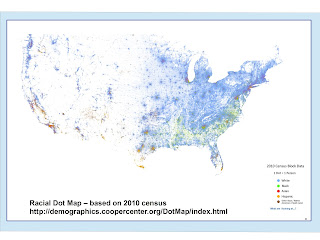
TiltaWhirlCarnival
Do you remember when we rode this merry-go-round in 2015? The graphic is from this blog article.
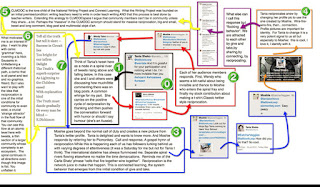
local with global—helping students make meaning
I saw the invitation to this article on Twitter and have read through all the comments. I see many familiar faces from the #clmooc network that stretches across the world. That's a global connection young people (and older) might learn from. Yet, it's still missing people, like myself, who work with youth outside of the traditional school setting.
In one Twitter chat we started looking at the #clmooc map and said "who's here and who's missing?". I searched in my blog to see if I could find that specific reference, and instead found a string of related articles. In one I post the concept map shown here.
Maybe part of what kids are being taught would be building an understanding of who is in the conversation, along with some skills for expanding the group, to include more local people, while connecting to more from around the globe. 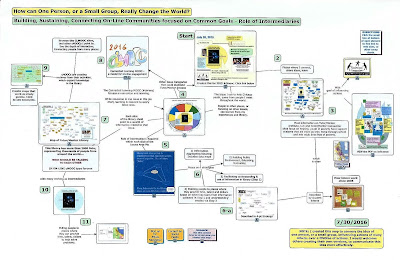
For the rest of us, then, our numbers and our power—inside and outside the academy—must grow.
Thanks for making this open to myself and others. I hope it attracts a growing number of readers from within your university.
Maybe my participation demonstrates the opportunities (or the negatives) of a public facing university.
But none of these arguments will be winning ones if the only people we’re trying to communicate them to are part of the less than two percent of the United States population with a doctoral degree, the thirteen percent with any advanced degree, or the thirty-five percent who’ve earned a bachelor’s degree (America).
This is critically important in so many ways. Not just to academics. There are many in this country and the world who have never been exposed to the ideas that are being shared.
Agree with "we need to regularly seek public connections -- to find or create them"
can be used to extend the reach of good scholarly ideas
There should be courses in high school and colleges to show students how to communicate ideas and influence others. Or just to expand their network and know how to ask for help when needed.
public-facing scholars
Are there web sites, or blogs, who create lists of people who do this really well, and also show what subjects they talk about?
When I was creating the Tutor/Mentor Conference in Chicago in the 1990s one goal (never reached) was to develop a database of speakers that we could draw from for conference speakers and that programs could draw from for their own training events.
That still would be a valuable resource.
Sulloway and Perry gave me gifts. They gave of themselves generously, not only to me but to many scholars and nonacademic publics.
This is how I feel about CLMOOC and why I point to it as a model others can follow.
It's got a huge internet footprint that others could study and learn from.
“Feminism,” she said, “is a social justice movement that argues that women have not been treated equally or fairly over the course of history and up to the present day.”2
It takes a lot of practice to be able to condense your thinking into a short sentence like this.
BTW - this also is a definition any of us can use in our social media if asked. Thanks Dr. Ruth Perry.
those who aren’t seen as “one of us.”
I saw this article on Terry's blog and said I'd try to take a look. I've read the entire article, now starting back through to offer some comments.
I'm one of those who "aren't seen as one of us". I'm not a classroom educator, or a college professor. Yet over the past 5 years I've been welcomed into the CLMOOC community and feel I've learned much while also sharing much at the same time.
This whole article speaks to the potential of engaging with audiences consisting of people like me.
the OpEd Project (www.theopedproject.org).
One of benefits of reading articles like this is that I find new ideas and links to share in my own web library. Hopefully others find and use this information as a result.
Where our scholarly research is concerned, it’s got to be about more than telling our truths and sharing our findings with those we assume are most like us.
This has concerned me for years. Researchers do a lot of work (with considerable funding) to generate new understanding of complex issues, then do a big publication splash. After that they move on to the next research, with limited time spent engaging with the broad public so that the ideas get put into action.
The Savoyard Count andthe Russian are both reacting, and reacting violently, against liberaloptimism concerning human goodness, human reason, and thevalue or inevitability of material progress: both furiously denouncethe notion that mankind can be made eternally happy and virtuousby rational and scientific means.
I'm one of those with unlimited optimism, yet in the back of my mind I'm filled with the pessimism which is described here.
the heralds of modernFascism
like I said, "how many current leaders follow this thinking?"
He emphasised the need for absolute authority,punishment and continual repression if civilisation and order wereto survive at all.
I wonder how many current world leaders, or "would be" leaders feel the same way.
but he believed onlyin one vast, unitary whole.
One vision to unite them all. If you follow the links on this concept map you'll find a vast universe of maps, all focused on helping kids grow up. Applies to any place in the world and can engage anyone in the process. Radiates out from solving this one problem to solving many others. 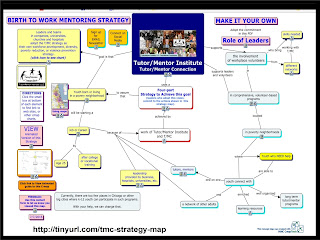
If we may recall once again our division of artists into foxes andhedgehogs:
Yes. Let's get back to talking about foxes and hedgehogs.
So far so good, and Tolstoy is judged to have shown deeperinsight–‘greater realism’–than most historians.
I'm about half way through. Not sure where this journey will lead me. It's been interesting so far.
the great illusion which Tolstoy sets himself toexpose: that individuals can, by the use of their own resources,understand and control the course of events.
If this is true, why try?
hose who affect to beable to contract this infinite multiplicity within their‘scientific’laws must be either deliberate charlatans or blind leaders of theblind.
Think of all the "talking heads" on Sunday morning TV or nightly MSNBC, FOX News, CNN, etc.
People were preoccupied bypersonal interests.
As we reflect on the rise and fall of Nazi Germany, or the rise of #POTUS45 and the GOP in the US, what we learn is that most people are not concerned, but really preoccupied by their personal interests.
the higher soldiers or statesmen are in thepyramid of authority, the farther they must be from its base
The CEO of Montgomery Ward corporation confided this same observation to me at a dinner in the early 1980s.
How can we escape the conclusion that thehistories which exist represent what Tolstoy declares to be‘perhapsonly0.001per cent of the elements which actually constitute thereal history of peoples’?
Put into current context. With so much information flowing across the internet, TV and other communications media, how do we know what is really the truth?
‘If we allow that human lifecan be ruled by reason, the possibility of life [i.e. as a spontaneousactivity involving consciousness of free will] is destroyed.’
maybe....
History would be anexcellent thing if only it were true.
A bitter, cynical, statement.
men accumulate a knowledge of facts asthey succeed each other in tim
does this describe our current education system?
a feeling thathistory, as it is written by historians, makes claims which it cannotsatisfy
Like realizing that what your elected and business leaders have been telling you is often filled with lies and deceit.
What is to be done? How shouldone live? Why are we here? What must we be and do?
Is it necessary to have a certain level of security, or wealth, to be able to have the luxury to think about these things?
History, only history
And yet, most of history is biased, having been written by winners, as well as those who were not actually present in the events they are writing about.
Hewas tormented by the ultimate problems which face young men inevery generation–about good and evil, the origin and purpose ofthe universe and its inhabitants, the causes of all that happens;
A set of questions that face young women, too.
Tolstoy’s life is normallyrepresented as falling into two distinct parts:first comes the authorof immortal masterpieces, later the prophet of personal and socialregeneration;first the aristocratic writer, the difficult, somewhatunapproachable, troubled novelist of genius; then the sage–dogmatic, perverse, exaggerated, but wielding a vast influence,particularly in his own country–a world institution of uniqueimportance.
Interesting.
falsification perpetrated, it seems, in theinterests not so much of an artistic as of an‘ideological’purpose.
Is this what POTUS45 and the 2019 GOP are doing?
charlatanism
My #clmooc friend Algot does daily word definitions on Mastodon. Would be great if he'd read along and provide definitions of some of the words being used in this article.
The hypothesis Iwish to offer is that Tolstoy was by nature a fox, but believed inbeing a hedgehog; that his gifts and achievement are one thing, andhis beliefs, and consequently his interpretation of his own achieve-ment, another; and that consequently his ideals have led him, andthose whom his genius for persuasion has taken in, into asystematic misinterpretation of what he and others were doing orshould be doing.
I've not read enough Tolstoy, or any other Russian writer to comment. Yet I understand how what one does can influence others to take a path that leads to nothing.
a starting-point for genuineinvestigation
If we think of this as a race, or a journey, the first step was taken by the writer, who put these words on paper. I'm sure many others have viewed this before Terry Elliot, but he took a necessary second step, by sharing it on Mastodon, then posting it here for annotated reading.
Without this second step, taken by many, the writing is lost in time, and this genuine investigation never starts.
lifelong learners with an ethos of social justice who support each other and learn through creative play
Sarah, as you write your thesis I encourage you to devote some space to how outliers such as myself have been welcomed into the group and have built growing relationships over time.
The graphic I've attached was created by Terry Elliott. He was the first one from 2013 who asked "Who is this guy?" following some of my posts in the G+ group. He reached out to me on Google Hangouts to determine if I was "ok". He's continued to take time to get to know what I'm talking about ever since, as have you and many others.
I'm on Twitter, Facebook and LinkedIN. You can introduce yourself in the comments section.
I've been ending many of my blog articles with an appeal for contributions, pointing to this link.
Few are responding. Maybe one reason is that I don't have a 501-c-3 tax status or non-profit organization supporting me (since 2011).
I just think, "Did Jesus have a formal 501-c-3 to collect donations and help to do his work?"
Thanks Terry Elliott for taking time to dig into my blog articles once again, and to invite others to join you.
It's my goal that others from throughout the US and the world will do exactly the same, then apply the ideas where they live, while working with others to overcome the institutional and structural hurdles we all face.
Cultivating Urban Literacies through a Pedagogy of Spatial Justice
I've worked with inner city Chicago youth for more than 35 years so the article resonates with me. It looks like Kara has built an extensive library of information and is teaching 8th grade students to dig into it.
If I were in a conversation with her I'd say "have you put this library on line? Are you teaching your students to come back to it often, and to add new information they find. Are you teaching them that the problems they are studying go back many generations and will still be in place many years in the future...unless these students continue to dig into the library as they grow to be adults, and learn to bring others to the library.
From this they might build a movement with enough people involved, that they could change the conditions of their neighborhood.
They also might model a process that could be duplicated in every other public school in Chicago and in other places.
I've attached a map showing one section of the web library I started building in the 1970s to educate myself, and the volunteers and kids in the tutor/mentor program I was leading. Here's the article where I used that graphic.
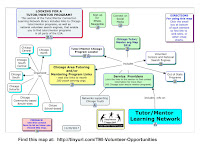
Reynolds School,
Is there a full name for this school? I searched the Chicago Public School site at https://cps.edu/Schools/Find_a_school/Pages/findaschool.aspx and can't find this school.
And finally
And, how do we build and sustain the public will needed to build these connected learning environments? 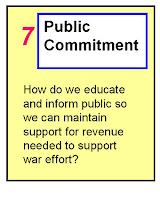
more visible to educators, parents, and policy and technology makers
This is "the village" I mentioned above.
far from realizing a world where all young people are able to fully engage in learning and opportunities
I'm going to introduce another annotated reading here, which is paper titled "Four Pathways to Greater Giving" which focuses on the philanthropy of the ultra wealthy.
An affinity group that should form is one where we innovate ways to tap this wealth and focus it on making these fully engaged learning opportunities available to youth in all neighborhoods, poor, and rich, throughout the world.
and in their local communities
Non school programs can expand the learning opportunities available to kids...if they are available, and if they are well designed. From article. 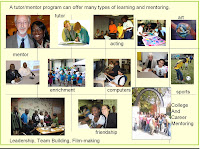
connected learning focuses on connecting young people’s interests and peer culture to opportunity and recognition in academic, civic, and career-relevant settings.
I've always added the focus on "adult learners" who need to be digging deeper to understand problems and solutions.
Maybe learning that habit needs to start when kids are entering school for it to be a habit, but can we wait 20-30 years to try to get adults more involved in solving the problems we face?
divides between in-school and out-of-school learning
I've been sharing this Adopt-a-Neighborhood graphic since mid 1990s, in articles like this. 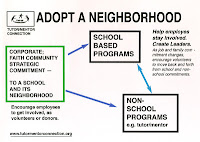
This disconnect
This disconnect is pictured in maps shown here, from article I posted last week.
A connected learning affinity network might consist of people in different cities/states who were mapping this data and sharing it on blogs, with same goals that I have.
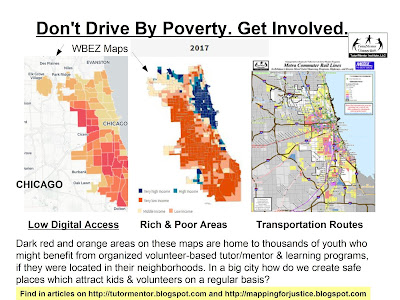
The majority of young people we spoke to did not find ways of connecting the learning in their online affinity networks with in-school, civic, or career-relevant opportunities
One of the challenges I've faced in building the Tutor/Mentor Connection since 1993, and Tutor/Mentor Institute, LLC since 2011, is that so few still use the internet to find people and ideas they can use to solve social problems. This article is one of many where I've focused on "deeper learning" and "it takes a Village". 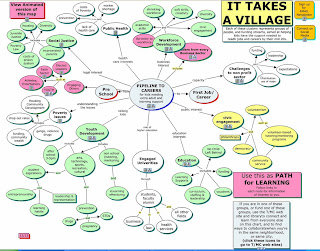
our schools, policies, community institutions, and workplaces have been slower to respond
I created the Learning Goals cMap in 2007 or 08 for the youth tutor/mentor program I was leading in Chicago, but never had enough time or support to make it a reality. Wrote about it here, under "Sharing Ideas. Who's Listening?" title.. 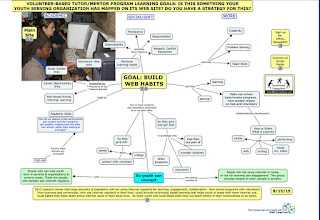
It is easy to forget that it has been less than a decade since these kinds of interactions became widespread in the United States.
This is so important. While human society has been developing for over 5,000 years, this connected world has developed in the blink of an eye. Imagine what it will lead to in 100 or 200 years.
giving from this population would move only from 1�2 percent to around 2�5 percent� Tha
There is so much wealth to unlock.
eveloping platforms to strengthen social-change efforts at scale is a major undertaking
Developing platforms is one major challenge. Sustaining them for a decade or longer, is an even bigger challenge.
the challenge of developing top-tier leaders� “
See comment above about "tipping points"
Strengthening social-change nonprofits
I created a presentation titled TIPPING POINTS in late 2000s to list some actions, which adopted, would improve the availability and quality of youth tutor/mentor programs in thousands of locations.
One of these focuses on setting up a program on one or more college campuses that offers a multi-year degree course preparing people to be leaders of youth tutor/mentor programs, and, that prepares other students to be donors and volunteers who support programs with such leaders, on an on-going basis.
Creating such a program and tying it to wealthy donors, or advisers of wealthy donors, would provide a "stamp of approval" on programs with leaders from such universities.
For ultra-wealthy giving to double, donors must have access to services that can meet them where they are and help “unstick” them in the moment they need it� Otherwise, matching ideas with dollars simply becomes too inefficient and time-intensive�
valuable insight
if they could access expert advice and learn lessons from their peers
This blog article describes the four part strategy we launched in 1993. The first step is collecting "all that is known", which should include all we can learn about what some donors are doing, so we could share that to support decisions and influence other donors.
Unfortunately, we've never found a single major donor to support this information gathering/sharing process. 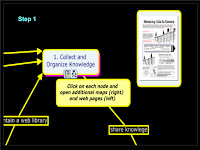
However, even though philanthropy is personal, many of the services that ultra-wealthy donors require have similar characteristics� If
I've used this graphic to visualize the intermediary role that connects those who could help, with information they use to support their decisions, and with places where help is needed. This applies here. 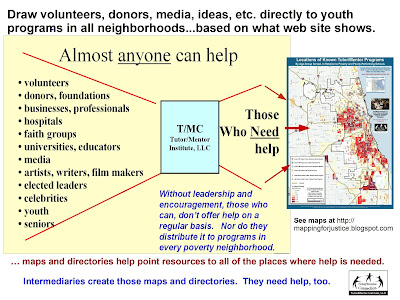
but those efforts are often short-lived�
Getting donors involved, and keeping them involved for many years is a huge challenge. I've used this graphic since 1990s to emphasize the 12 years it take to go from 1st grade to 12th grade and an additional 4-6 years to move through college into jobs. Funding programs that provide this support, in thousands of high poverty locations, is not happening. 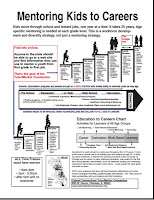
there is rising public and philanthropic interest in providing an equal opportunity for every resident to climb the income ladder�
Just getting high impact donors into conversation with myself and others trying to innovate solutions would be a step in the right direction.
-Impact h
web site is https://www.co-impact.io/
Blue Meridian Partners
web site is https://www.bluemeridian.org/
Platforms that source
This graphic visualizes the platform I have been trying to build. All the information in the Tutor/Mentor Institute, LLC web site and blogs supports this vision. I introduced the platform graphic in this 2012 blog article.. 
A services hub that provides premier insights,
Again, this is what the Tutor/Mentor Connection has intended to be....but never attracted a single major champion to take it to reality.
A new institution that offers the benefits of a DAF,
The Tutor/Mentor Connection was created with this in mind, and the partnership we formed om 1994 with the Lawyers Lend A Hand Program at the Chicago Bar Foundation, was progress toward this goal. However, multiple changes in leadership at CBF kept diluting the initial partnership agreement, until it no longer was a partnership and ceased to exist.
success often emerges only after decades of perseverance�
see comment above
or many, for a risk to be worth taking, the probable gains must far exceed the potential losses� D
The big challenge is that complex problems are slow to change and hard to predict the path that will lead to identifiable change.
Getting donors, and volunteers, along for the ride, has always been one of the challenges of my work.
much easier for donors to fund hospitals, arts institutions, and universities
with this in mind I've been trying to find a donor who would make a major gift to a university, with the restriction that it would fund a Tutor/Mentor Institute (drawing from what I've been doing, with me in a consulting/teaching role) on their campus.
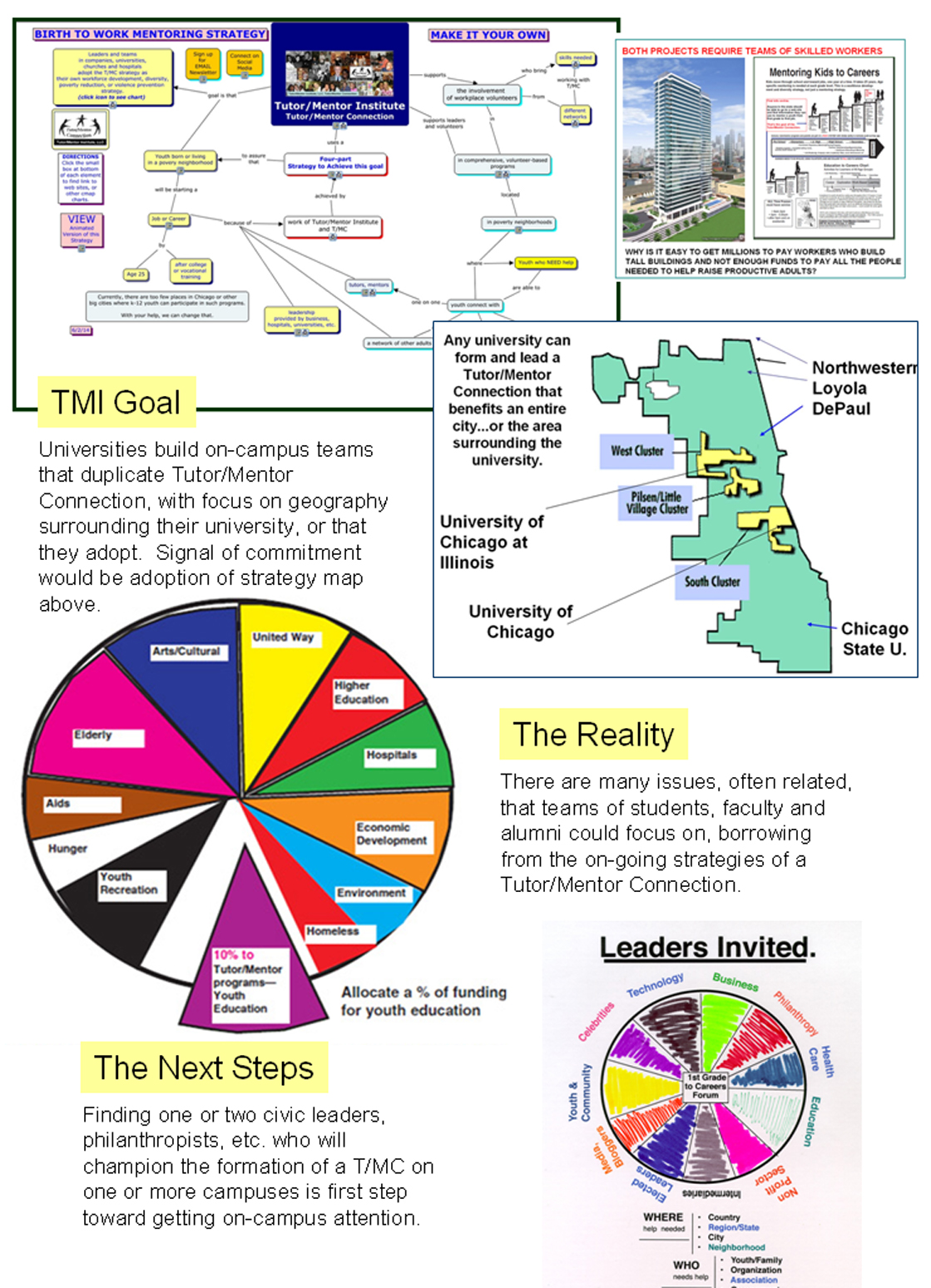
skill sets and invested the time to structure, seek, and effectively absorb such gifts�
I started building a knowledge base in 1993 with the belief that others could use it to innovate new solutions, by borrowing from what others are already doing in different places. Many of my blog articles focus on this in one way or another.
In this link I point to articles that include "tipping points" ideas. What would need to happen to build a knowledge base that prepared super rich to support social change non profits, and at the same time, prepare those non profits, to integrate major gifts into their work? 
Why would I tilt at windmills? I’m struggling to keep three months of cash on hand to make payroll�”
I lived this life from 1990 to 2011. Now as an LLC, it's even more difficult.
few opportunities to share concerns and knowledge with peers in a confidential and curated space
This troubles me. I spend time on line daily because I believe a few billion others, including the super-wealthy do, too. Around 2004 Pierre Omidyar, one of eBey founders, launched a web platform dedicated to "doing good". This drew many who thought it was a place to attract attention and support from Omidyar, and his wealthy friends. That did not happen, and the frustration led to negative comments, and the site was eventually shut down.
Thus, I can see how someone with wealth would be cautious about entering on-line space, like a #clmooc discussion.
Yet, unless we can make that happen, the ability to engage, build trust, and build support, will be limited to only a lucky few.
struggle to find a trusted advisor
Since forming a partnership with the Chicago Bar Foundation's Lend A Hand Program in 1994 I've tried to build a team of lawyers, bankers, investment advisors, etc. who would meet quarterly to talk about ways to guide donor investments to youth tutor/mentor programs in high poverty areas of Chicago and other cities.
It's a dream that never reached reality.
working to solve society’s most pressing challenges
Support from just one wealthy family for a 20 year period could make the Tutor/Mentor Connection available and fully operational in every US city and many others around the world. This is from a page on the Tutor/Mentor Institute, LLC planning wiki, showing ways to use maps to build capacity. 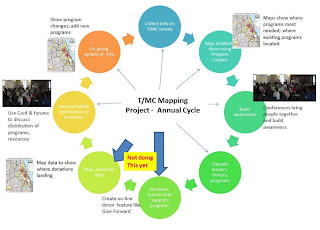
the great majority of wealthy Americans’ philanthropic giving goes to large institutions—such as universities, hospitals, and cultural institutions—that are vital to a healthy society,
These feed the donor's ego and legacy, but do little to fix the inequalities and injustices in society.
If current appreciation trends continue, donors seeking to channel half their wealth into philanthropic causes within the next 20 years would have to contribute over 11 percent of their wealth annually—nearly ten times the current rate of giving�
Imagine the potential benefit if that goal were achieved, and distributed into the largest metropolitan areas of the USA? This article shows the map I've attached, plus the United Nations Global Goals. It's not reasonable to expect all giving to focus on the USA. So what if only 1/3 of 11 percent per year went to fund social and environmental efforts in US cities? 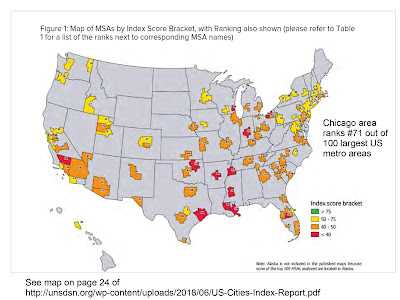
just because an organization builds a model for better giving, it doesn’t necessarily mean that others will run with it
I've been collecting information in a web library for more than 20 years, with the goal that others would learn from work done by others, instead of constantly re-inventing the wheel. Here's one article where this graphic is used. 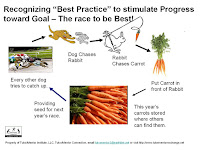
firsthand accounts from more than 60 ultra-wealthy families,
This sounds like a good sample, but since there are 2000 ultra-wealthy, and each is probably pretty unique in their thinking, I'd wish for a larger base of interview participants.
beginning of an estimated $30 trillion wealth transfer
I've long believed that volunteer-based tutor/mentor programs that get volunteers involved when young, and keep them involved for a lifetime, could unlock much of this wealth transfer and bring it into our sector. This graphic (see article) visualizes this type of support. Too few of the programs I look at show this type of thinking on their web sites. 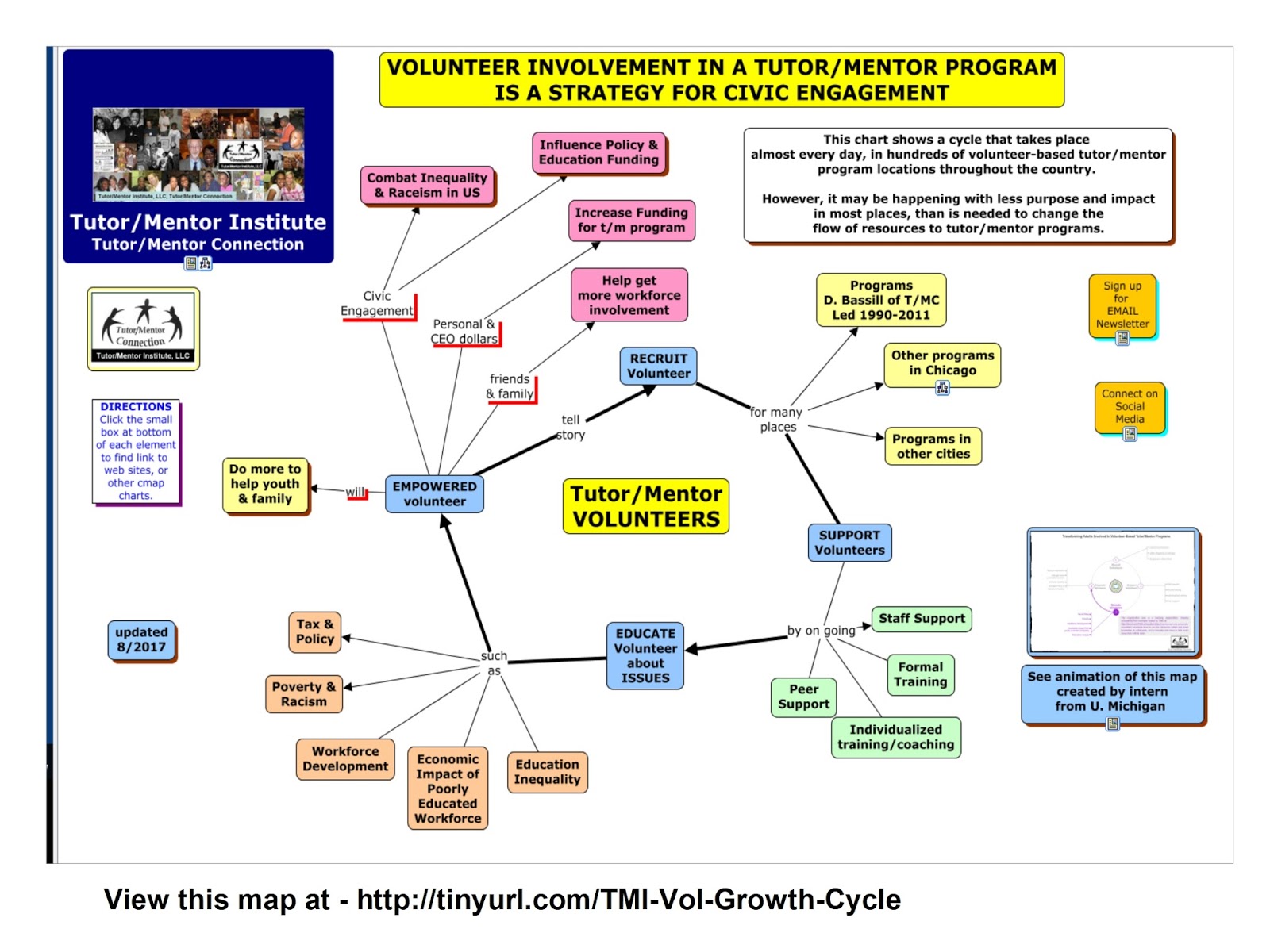
The Bail Project,
web site is https://bailproject.org/
Family Independence Initiative
web site is https://www.fii.org/
social-change efforts
I will need to look for some visualizations of what they mean by "social change efforts". I've attached a graphic from one of my blog articles, visualizing challenges in the social change of helping kids from poverty areas through school and into adult lives. 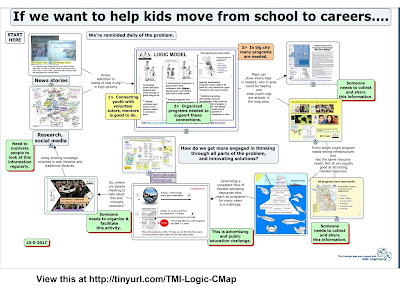
p tier of social-change focused nonprofits
This is favoritism. There are many small, unknown, non profits with great ideas and strategies, that could be developed with the support of major philanthropists.
Compared to institutional nonprofits like hospitals and universities, social-change organizations operate at a major disadvantage
My brother-in-law was on the board of a big hospital and always asked why my small non profit could not raise money as easily as his hospital. He never understood the differences.
Private wealth management firms in the for-profit sector,
Since the mid 1990s I've tried to have the Tutor/Mentor Connection strategies adopted by one or more wealth management firms. Using their talent they could communicate strategies from my site much better than I can, and can mobilize donors to support those strategies.
The END Fund
web site is https://end.org/
Blue Meridian Partners
web site is https://www.bluemeridian.org/
causes like human/social services, the environment, and international development�
I created this graphic in an effort to show how the United Nations' Global Sustainability Goals (SDGs) are also local challenges. Investment needs to flow into each node on the map, and each SDG goal, and into every geographic location where this issue needs to be addressed. see article 
most nonprofits are unpracticed at making the case for gifts of eight-figures (or more)� L
This is the paradygm that I want to change. Donors have the money to invest more in deciding where to give. Teach them to pick out organizations to support based on geography (where is need located) and organizations already working within the chosen geography, on the selected issue. Invest in building up organizations rather than constantly supporting new ones that just compete with existing ones. Unless there is a real need to do this.
double ultra-wealthy giving to benefit society from $45 billion to $90 billion per year
If the above percent is correct, this is just a growth from 1.2 percent to 2.4. What if it grew to 10% or more?
if an ultra-high net worth family wanted to spend down half its wealth in a 20-year timeframe
Great goal. How do we convince those 140 families, and others with lesser degrees of great wealth, to make this commitment.
What will it take
I decided to annotate this report as I read it, since the topic is something I've been interested in for more than 20 years. I've attached a graphic from this blog article, advocating for wealthy philanthropists to adopt neighborhoods with on-going, long-term, flexible support. 
schools should be places where students experi-ence “education as a practice of freedom” (hooks, 1994), and not places they feel compelled to “step away” from because some teachers do not believe they can achieve.
Is anyone studying universities to see which are teaching these ideas to new educators, and attempting to also teach them to people already in the field?
When schools partner with students, families, community organizations, and social service agencie
I've been on Twitter since late 2000s and involved with the Connected Learning Community (#clmooc) since 2013. Through them I learned of Hypothes.is and this project with MarginalSyllabus. I keep sharing my experiences with non-school programs in Chicago and beyond with the hope that more program leaders, volunteers, donors, business partners and others will join in.
Until there is engagement there's little hope for partnership.
We are aware that schools cannot do it alone—that is, schools cannot by themselves eliminate all forms of educational inequities and social inequalities, given that these are large-scale systemic issues rooted in structural oppression. H
Thanks to Marginal Syllabus for making this available for non-educators to read. I agree with this statement. Schools cannot do all that's needed. We need to get the rest of the extended community involved, creating learning experiences and opportunities like Khaleeq and Rendell are having.
When school is not enough, how might students learn to cultivate their literacies, nurture their spirits, and chart their own trajectories within out-of-school spaces?
I've participated in the Marginal Syllabus annotations for more than a year and keep coming back because of the focus on issues that I've been focused on for more than 25 years. I hope many, many educators will read and comment, and that each will invite a few non-educators from the broader community to also join in. This is a problem that requires involvement of a wide range of people, not just educators.
an effort to connect people
Happy to see Terry Elliott, a college professor from Kentucky and Kevin Hodgson, a middle school teacher from Massachusetts, digging into my blog article. Would love to find people from Chicago non-profits, philanthropy, gov't and media making as much of an effort to read, reflect and share what I've been writing about for 25 years.
Canaries in the Coal Mine
Here's story of origination of the Canary in Coal Mine. What warning are you pointing to?
/https://public-media.si-cdn.com/filer/8a/1e/8a1e34af-4aa0-485c-9958-9c4dd5edd837/canary.jpg)
What I know for sure is that as the adults in their lives, we need to make sure the space is there—
This is a commitment that many adults need to make, and sustain for many years and in many, many places.
instances of violence are normalized in the lives of young people.
In this article I describe a writing activity that could involve youth from schools and non-school programs throughout Chicago and any other city. So far I've found few takers. Maybe some of you, and the youth you work with, will be interested.
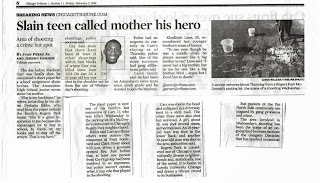
began holding free writing workshops at local community organizations and public libraries.
This is so important.
Because I maintained a database of non-school tutor/mentor programs in Chicago I was often called by parents, grandparents, social workers, etc. asking if there was a tutor/mentor program available for a youth in their family, or who they were working with. Often, as soon as they gave the age and zip code, I knew there was no program available for that youth. When I said this there was a strong sense of frustration clearly apparent from the caller.
Then I would add, but there could be a program if you or others in your neighborhood did the work of starting one. And I offered that the resources in my web library could help them.
Too few took me up on this offer.
That's why hearing how this program was started is exciting.
history of school failure
I've been building a web library since 1998 to aggregate information like this, to help educate others. The concept map I'm pointing to outlines the research section of the library. Each sub section includes dozens of articles. Much of my library focused on Chicago so other cities should have someone building a similar library, focused on their own city.
